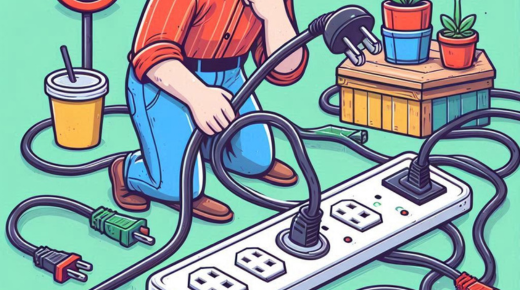Power strips and extension cords are essential tools in many homes and offices, helping to manage multiple devices and extending access to outlets. But sometimes, we might wonder whether it’s safe to combine these two electrical items. Can you plug a power strip into an extension cord? It seems like a convenient solution when outlets are scarce, but is it safe?
In this article, we’ll explore the potential risks and explain why experts generally advise against this practice, as well as how you can safely use both devices together.
Why You Should Avoid Plugging a Power Strip into an Extension Cord
Plugging a power strip into an extension cord creates an electrical setup that can quickly become dangerous for several reasons:
1. Overloading and Overheating
Both power strips and extension cords have a maximum current capacity, typically measured in amps. When you plug a power strip into an extension cord, the extension cord’s total power rating becomes the limiting factor. If the devices plugged into the power strip exceed the safe capacity of the extension cord, you risk overloading the circuit. This can cause overheating, which can lead to fire hazards.
2. Increased Risk of Short Circuits
Combining these two devices creates multiple layers of electrical connections, increasing the risk of loose connections or short circuits. If the power strip’s cord or the extension cord becomes damaged, you could end up with exposed wires or faulty connections, leading to electrical shocks or even sparks.
3. Potential Violation of Electrical Codes
In many regions, using an extension cord and power strip in combination can violate electrical safety codes. Extension cords are designed to provide temporary access to outlets, while power strips are meant to extend the number of available outlets. The misuse of these devices can result in non-compliance with electrical regulations, which can be dangerous, especially in commercial spaces or areas with strict safety standards.
When Is It Safe to Use a Power Strip with an Extension Cord?
While experts generally advise against plugging a power strip into an extension cord, there are some scenarios where it could be done more safely:
1. Check the Ratings
Before attempting to combine a power strip and an extension cord, ensure that both devices are rated for the total wattage or amperage of the devices you plan to plug in. For example, if you have a 12-amp power strip, and you want to plug in a 10-amp extension cord, you would exceed the total capacity, leading to potential overload. Always check the manufacturer’s specifications and ensure that both the power strip and extension cord can handle the combined load.
2. Use Only Heavy-Duty Extension Cords
If you absolutely need to use both a power strip and an extension cord, opt for heavy-duty extension cords that are rated for high current. These cords are designed to handle more significant electrical loads and provide better safety when used in conjunction with power strips.
Better Alternatives for Power Management
Rather than risking a potentially hazardous combination of power strip and extension cord, here are some safer alternatives for managing your power needs:
1. Use a Longer Power Strip
Instead of using an extension cord, consider opting for a longer power strip. Many power strips come with 10 to 15-foot cords, allowing you to reach distant outlets without needing an extension cord.
2. Invest in Surge-Protected Power Strips
For added protection against voltage surges, choose surge-protected power strips. These strips can protect your devices from unexpected spikes in electrical power, such as those caused by lightning storms. GONEO power strips, for example, offer built-in surge protection, so you can rest assured your devices are safe from power fluctuations.
3. Upgrade to Smart Power Strips
For even more control, consider upgrading to smart power strips. These strips can automatically manage power to connected devices, cutting off power when no longer needed, which can reduce the risk of overloading and save energy.
Conclusion: Safety Comes First
While it might seem like a simple solution, plugging a power strip into an extension cord is not recommended by experts. The risks of overloading, short circuits, and violating electrical codes outweigh the convenience. Instead, opt for safer alternatives like longer power strips, heavy-duty extension cords, or even smart strips that can better manage your power needs without compromising safety.
If you ever feel uncertain about your power setup, consult a licensed electrician to ensure you’re using your equipment correctly. Products like GONEO power strips, known for their high quality and safety features, can provide peace of mind when it comes to protecting both your devices and your home.




